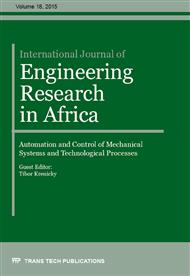[1]
B.J. Roylance, T.M. Hunt, The wear debris analysis handbook, Coxmoor Publishing Company, Oxford, UK, (1999).
Google Scholar
[2]
P. Blaškovič, J. Balla, M. Dzimko, Tribology (Tribológia), ALFA, Bratislava, 1990 (in Slovak).
Google Scholar
[3]
N. Govindarajan, R. Gnanamoorthy, Ferrography – A procedure for measuring wear rate, Indian Journal of Engineering &Materials Science 15 (2008) 377-381.
Google Scholar
[4]
S.M. Laghari, A.O. Memon, A.G. Khuwaja, Knowledge Based Wear Particle Analysis, International Scholarly and Scientific Research & Innovation 1/12 (2007) 892-896.
Google Scholar
[5]
R. Surapol, Wear particle analysis - utilization of quantitative computer image analysis: A review, Tribology International 38 (2005) 871-878.
DOI: 10.1016/j.triboint.2005.03.013
Google Scholar
[6]
V. Leavers, New Advances in Wear Debris Analysis, Machinery lubrication 8 (2012), Information on http: /www. machinerylubrication. com/Read/29029/new-advances-in-wear-debris-analysis.
Google Scholar
[7]
B. Fitch, Anatomy of wear debris, Machinery lubrication 10 (2013), Information on http: /www. machinerylubrication. com/Read/29537/wear-debris-anatomy.
Google Scholar
[8]
R.K. Upadhyay, Microscopic technique to determine various wear modes of used engine oil. Journal of Microscopy and Ultrastructure 1 (2013) 111-114.
DOI: 10.1016/j.jmau.2013.09.002
Google Scholar
[9]
R. Majdan, Z. Tkáč, P. Ševčík, Š. Drabant, Š. Jánošík, The Test of Hydrostatic Pump and Hydraulic Fluids by Department of Vehicles and Heat Devices, Proc. of Interfaces'08, Sopron, Slovnaft - Member of the MOL Group, 2008, pp.152-159.
Google Scholar
[10]
S. Ebersbach, Z. Peng, N.J. Kessissoglou, The investigation of the condition and faults of a spur gearbox using vibration and wear debris analysis techniques, Wear 260 (2006) 16-24.
DOI: 10.1016/j.wear.2004.12.028
Google Scholar
[11]
A. Panda, M. Jančík, J. Jurko, I. Pandová, Composite materials as suitable materials in industry - automotiv and aircraft used, Biosecurity and Technical, IBEN Gorzow, Poznan, 2014, pp.35-55.
Google Scholar
[12]
M. Sejkorová, Methods of tribotechnical diagnostics (Metody tribotechnické diagnostiky) VSB-Technical University, Ostrava, 2013 (in Czech).
Google Scholar
[13]
M.C. Isa, N.H.N. Yusoff, N. Hasril, S.D.Y. Mohd, M.M. Muhammad, M.N. Irwan, Ferrographic analysis of wear particles of various machinery systems of a commercial marine ship, Procedia Engineering 68 (2013) 345-351.
DOI: 10.1016/j.proeng.2013.12.190
Google Scholar
[14]
J.A. Williams, Wear and wear particles—some fundamentals, Tribology International 38 (2005) 863-870.
DOI: 10.1016/j.triboint.2005.03.007
Google Scholar
[15]
P. Čačko, T. Krenický, Impact of lubrication interval to operating status of bearing, Applied Mechanics and Materials 616 (2014) 151-158.
DOI: 10.4028/www.scientific.net/amm.616.151
Google Scholar
[16]
J. Mihalčová, I. Čorný, M. Rimár, Diagnosing a state of auxiliary gas turbine engine by tribotechnical diagnostics methods, in: Operation and Diagnostics of Machines and Production Systems Operational States: Scientific Papers Vol. 3, RAM-Verlag, Lüdenscheid, 2010, pp.84-88.
Google Scholar


